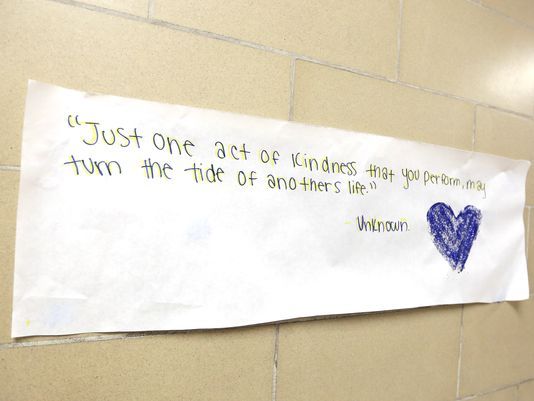The day after an Instagram account called The Whiteaker Bitches was taken down, "whiteaker_bitches69" was created and the cyberbullying of Whiteaker Middle School students continued.
Parents and students, again, reported the harassment to police and posted about it on Facebook. And even though the second Instagram account has now disappeared, more reports of bullying have come to light this week throughout the Salem-Keizer School District.
The abuse appears widespread, based on interviews with parents and staff, including fight clubs, digital photo manipulation of students into pornographic images, boys asking for nude photos of girls and posting them, and body shaming that has lead to students being hospitalized for suicide attempts.
Almost 30 percent of middle schoolers in Oregon reported being bullied within the month prior to answering a 2015 survey on student health.
Additionally, one out of every four students, according to the National Center for Educational Statistics, reports being bullied during the school year, most often concerning their looks, race or body shape. Another study showed 64 percent of those bullied did not report the abuse.
Bullying has been linked to absenteeism, depression, self-harm, more bullying, suicide and domestic violence. Psychologists say those who bully are also at risk for many of the same problems.
With access to today's technology, students can never escape the treatment as likes and shares from other students perpetuate the behavior. State statutes and school district policies don't always have enough teeth to stop cyberbullying.
Experts say solutions lie in better legislation, adults leading by example and a cultivated culture of kindness by the students, in which it's "cool" to shut down bullying rather than participate.
There is no escape
Kristi Ali-Winn, a Salem-Keizer parent, has battled extreme bullying against her daughter, resulting in school transfers, counseling and countless conversations with school and district officials and policemen.
When Ali-Winn's daughter was bullied, her school rearranged her lunch schedule so she wouldn't interact with her tormentors and allowed her to leave school ten minutes early. But the cyberbullying followed her no matter the attempts to remove her.
"Some people have no idea what their kids are doing on their phones," she said. The victims "can't even feel safe in their own home."
Even "good kids" are participating, she said, describing cyberbullying as an epidemic. "It's like a virus — it spreads so easily."Jacque Walker, a teacher at Whiteaker Middle School, has heard many bullying stories from students and witnessed it as a parent.
Walker has to combat the immediate satisfaction of bullying that earns the student social clout and an adrenaline spike, which Walker compared to "the hit of a drug."
Studies show young people who witness aggressive behavior in adults mimic and expand on that behavior, as reported in a recent Associated Press article. An example is Stanford University psychologist Albert Bandura's famous "Bobo Doll Experiment," which found kids who saw adults hit a doll in frustration not only hit the doll, as well, but attacked it with weapons.
Social media is an atmosphere devoid of social cues that mitigate behavior in real life, Karen North, a psychologist and director of the University of Southern California's Digital Social Media Program, told the AP. When violating social norms in person, there's immediate feedback from others through body language and tone of voice. No such indicators exist online and retweets can feel like validation.
Cyberbullying expert Nancy Willard said some of the online behaviors show an underlying theme of sexual harassment people should be paying attention to.
"What is happening online is a red flag for a deeper problem," she said.
Psychologists recognize bullying as a group phenomenon, according to the American Psychologist Association. The behavior is a result of multiple relationships with peers, families, teachers, neighbors and societal influences, including social media.
Studies have found bystanders often respond in ways that encourage the behavior, rather than discourage it. However, those who defend victims tend to have greater empathy and higher social status.
Walker works with Whiteaker students on a consistent basis. And the school is one of about 200 across the country that participates annually in the Great Kindness Challenge, a week-long program that focuses on positive acts.
She has them write essays on bullying, write letters to the governor, watch videos about tragic stories involving bullying and hosting philosophical discussions where students are asked questions like, "If you bully someone to death, is that manslaughter?"
"As adults, we need to be the change makers," she said.
But parents like Ali-Winn worry students don't care about the effect of their actions because they know there probably won't be any real punishment.
A lack of consequences
Oregon statutes, updated in 2010, require schools to take action if bullying takes place on campus, during school time or on the way to or from school.
Some districts, including Salem-Keizer, take it a step further, saying schools are responsible for bullying away from school when it affects a child's ability to learn in the classroom.
But many argue these rules aren't enough.
"Whatever consequences they already have clearly aren't working," Ali-Winn said. "Bullying in the district is out of control."
Cyberbullying spans districts across the country.
After a student in San Antonio, Texas, who was bullied online committed suicide, his parents fought to see Texas legislation changed to include cyberbullying.
Other states, such as New York, are following suit to update their statutes, but cyberbullying remains a gray area for many policymakers.
Oregon law is not always clear as to when bullying — especially cyberbullying — becomes a crime.
When there is a threat of physical harm, someone can file harassment charges. If the bullying involves physical harassment, damage to property or sexually explicit photos online, the perpetrator could be charged with various things, including distribution of pornography or child pornography.
Generally speaking, using social media or other means to bully a person or group of individuals is not a crime in Oregon, said Jeff Kuhns, a spokesman for the Keizer Police Department.
"Any involvement we generally have with these types of incidents ... is to make some effort to identify who is involved," he wrote. "If we are able to do that and the individual(s) is a juvenile, we will generally attempt to contact the parents of the juveniles who are engaging in such activity to advise them about the inappropriate comments or posts that are being made."
Nichol Schauer, another Salem-Keizer parent, said the police told her there was nothing they could do when her child was bullied online because of the attacker's freedom of speech.
Schauer still filed a complaint with the department, which is waiting to be approved.
"The first thing these little girls say to each other is, 'You should just kill yourself — no one likes you," she said.
These incidents have encouraged Schauer to make change happen at the legislative level.
"Parents should be aware the laws aren't up to date," she said. "We want the laws to catch up to the technology."
Where do families turn?
When Ali-Winn sought help for her daughter from police and school officials, she didn't get far.
"Everybody's feeling like their hands are tied," she said.
Yvonne Rogers, whose granddaughter was bullied at Parrish Middle School doesn't believe the Whiteaker bullying is an isolated incident.
"Things like bullying go on all the time, told to deaf teachers," Rogers said. Schools, she argued, are not proactive when it comes to reporting and addressing bullying.
Julia DeWitt, Whiteaker principal, Larry Ramirez, director of High School Education for the district, and Matt Biondi, director of Middle School Education, were unavailable for comment on this story. Biondi said last week it may be difficult for school officials to look into the incidents at Whiteaker during the summer months.
"Cyberbullying and any other form of harassment, bullying and intimidation are not tolerated," said Jay Remy, a spokesman for Salem-Keizer. "The bottom line is that, according to law and policy, every student has the right to an education in a school environment where they feel safe, welcomed and included."
Willard, director of Embrace Civility in the Digital Age, recommends officials work to create a school atmosphere at Whiteaker, and all schools, where students refuse to tolerate bullying.
"If they weren't achieving social status by doing this, they wouldn't be doing it," she said. "They'll shift the tide."
She suggested Whiteaker staff works with the student leadership classes on the issue. Over the summer, however, it is important the school reaches out to parents.
"It only takes one or two students to say this is wrong to shut it down," Willard said. She suggests parents help their children recognize bullying behavior, know how to respond and where to report it.
"We know about (Whiteaker) because a responsible student told an adult," she said.
Contact Natalie Pate at npate@StatesmanJournal.com, 503-399-6745, or follow her on Twitter @Nataliempate or on Facebook at www.Facebook.com/nataliepatejournalist


